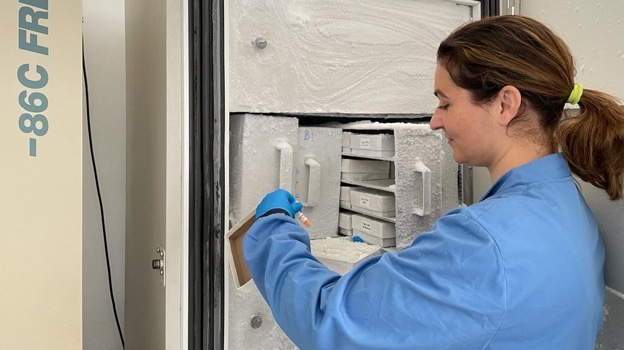Since 2021 The microbiologist Mari Carmen Montero Calasanz (1979, Arahal) has been waging at the Andalusian Institute of Agriculture and Fisheries Research and Training (Ifapa) of 3,600 bacteria into a “collection” that will illuminate the light is where he wanted to turn on a collection. serious problems that affect agriculture and the environment. Since he finished his degree in Biology (University of Spain) in 2003, he has gone through more interesting professional prosses. He spent ten years abroad (Germany and the United Kingdom), for specializing himself in microbial systematics and functional genomics, with applications in sustainable agriculture.
This physicist talks excitedly about everything his research team is doing, especially what they have to do. Because the Department of Inoculants IFAPA Las Torres, located in Alcalá del Río, has for more than 45 years selected thousands of bacteria from the main agricultural products of Andalusia,”The only microbial reservoir in Europe that has great biotechnological possibilities in agriculture and the environment and has yet to be profit-oriented.
For this motivs, its objective is to access these biological resources and the “Collection of Andalusian microorganisms in agricultural and environmental aspects”, which will also be a medium for the long-term conservation of these expedient. “With climate change and ecosystem degradation,We’re losing a lot of biodiversity, which translates into a myriad of potential biotech losses,” he notes,
“Taxonomists are fans of science.” This is how Arahalens biologists define its characteristics. After he obtained his doctorate degree through a pre-doctoral grant funded by the FPI of the Republic, in the role of the distinguished German professor Hans-Peter Klenk,The German microorganism collection of the Leibniz Institute-DSMZ, filled with twenty microorganisms, arrived at this time. Receive a research proposal and a one-year postdoctoral contract funded by the European Social Fund through IFAP.
Excellent track record
During his first year working in Germany, he published five articles on his research in specialized journals. He recruited and managed his own research group, where he remained until his mentor, Professor Klenk,”To whom I owe who I am”, brought him to his dream office in Newcastle, UK.
In England he again formed his research group, taught undergraduate and graduate classes, and had his children. He stayed almost because the resources that this country uses in research and situational activities have nothing to do with Spain.He is still guided by the Spanish teacher of three students of this university. But the roots pulled it up, and today it lives
in Arahal.
He arrived in Spain in 2021, through a five-year contract from the Ramón y Cajal program, which aims to incorporate Spanish or foreign research workers at an excellent pace.He, along with his colleagues in the Department of Inoculants, conducted several studies on the use of microorganisms as biofertilizers, biomediators against pests and diseases, and biomediators of toxic compounds in a sustainable agricultural framework.
In particular, one of these lines proposes the use of drugs for the concentration of heavy metals in fertilized fields.”Well-managed manure applications are a eco friendly replacement to chemical fertilizers because they are rich in nitrates and phosphorescents. Yet the high concentration of heavy metals they now present means that their application over the years has become more of a problem than a solution, as the metals accumulate in the soil.”
Animals gets these heavy metal through food. At low mass they are essential microelements for the proper functioning of the body, but at high mass they produce an antibacterial effect and prevent infection, which is used by farmers who use very limited antibiotics.
In this project, funded by the Restoration, Transformation and Resilience Plan, microorganisms are attached to the roots of vegetables, which promote better growth without the need for nitrogen fertilizers, while also favouring the extraction of metals in a suitable range that allows medical use. Feed for livestock means reducing soil pollution and improving fertility, as well as achieving bio-safe feed utility for animal consumption.
NASA and the Coronavirus
This specializers in the use of microorganisms in dryland agriculture and his collection includes specimens from almost every desert in the world (Sahara, Chad, Negev, Mojave, Sonora, Amargosa, Atacama, Antarctica), as other archaeological sites in Italy, Tunisia and Turkey.”Until recently, they were believed to have no valuable life and were rich in bacterial diversity, whose biotechnological potential was not being exploited.”
Their research importance is that they live in conditions of high radiation and desiccation. “Imagine the many applications that could be found in agriculture in arid regions, in dyes containing free radicals, which age or simply act as sunscreens.”Thanks to these microorganisms from dry soil, the researcher has some cooperation with NASA, because these microorganisms can survive in the Martian atmosphere and can be used as a biological chassis, helping to implement these tools in the human colonization of this planet.
One microbiologist explained the importance of taxonomy while the time of corona.”This tree message was created by taxonomists, who explained how similar viruses already existed in nature and how they evolved when they mutated and new forms emerged.Presumably, this virus already existed in animals but jumped into the human species.”
Marie Carmen Montero used this joke several times in her class to convince her students that because of the world’s great biodiversity, bacteria can be separated into “the good, the bad, and the ugly.”distinguishable as (to mimic the title of the Sergio Leone-directed film starring Clint Eastwood).
This is a human perspective, but there are species that do well, infect, or that spoil the aesthetics of food, but do not harm its use. Advances in the study of microorganisms mean identifying their metabolism, their interactions, and the benefits they can bring to living things and habitats. Arahalens biologists have worked for 20 years for this purpose.




